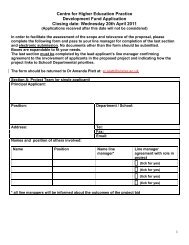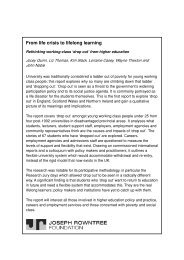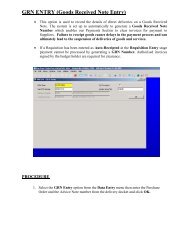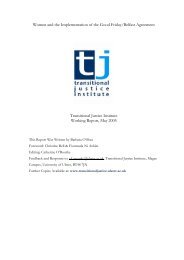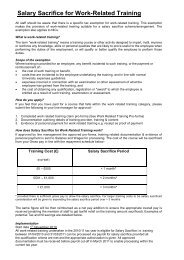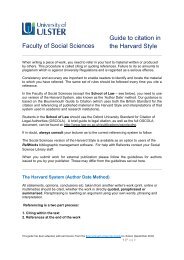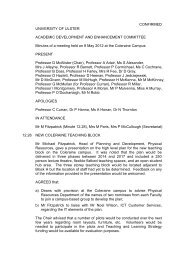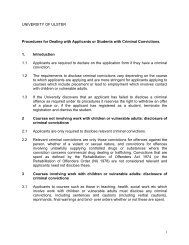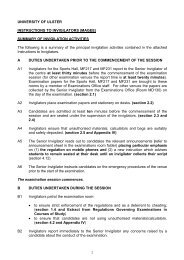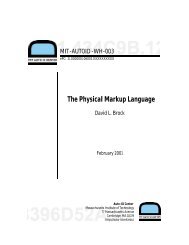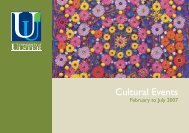You also want an ePaper? Increase the reach of your titles
YUMPU automatically turns print PDFs into web optimized ePapers that Google loves.
DISCOVERING THE STRUCTURE OF<br />
X-ray<br />
photograph of<br />
<strong>DNA</strong> taken by<br />
Rosalind Franklin<br />
at King’s<br />
College London<br />
<strong>DNA</strong><br />
THE DISCOVERY OF THE STRUCTURE OF <strong>DNA</strong><br />
as announced by Francis Crick and James Watson in their 1953 paper A Structure for Deoxyribose Nucleic<br />
Acid published in Nature was a landmark moment in biology...but who else contributed to this <strong>discovery</strong>?<br />
SPECIFICATION CONTENT<br />
Old: Know the different approaches used<br />
by Crick and Watson, (limited to modelling) and<br />
Franklin, (limited to X-ray crystallography) when<br />
researching the structure of <strong>DNA</strong>. New:<br />
Describe (in outline only) how the work of<br />
Chargaff, Franklin and Wilkins, and Watson and<br />
Crick, using different lines of evidence, led to<br />
the <strong>discovery</strong> of <strong>DNA</strong>; know that the<br />
development of the scientific theory of the<br />
structure of <strong>DNA</strong> is an example of the<br />
collaborative nature of science, and how new<br />
scientific knowledge is validated (for example<br />
peer review).<br />
STARTER<br />
Play kinaesthetic true or false. Read<br />
statements and ask class to make a T (stand<br />
up, arms out) if the answer is true, or an X<br />
(stand up, arms crossed) if the answer is false.<br />
Alternatively, to focus on how science works,<br />
use the ‘would you rather...?’ activity.<br />
STIMULUS<br />
Begin by asking students to read about 6<br />
contributions to the <strong>discovery</strong> of the structure<br />
of <strong>DNA</strong>. Working in 3s, ask them to rank the<br />
contributions in order of importance on the<br />
pyramid grid. Discuss justifications. Have a<br />
colleague deliver the letter to the problem page.<br />
Ask students to discuss letter in pairs.<br />
QUESTIONS<br />
Allow some individual thinking time, then<br />
ask students to write the question they think it<br />
is important to address on a post it. Share in<br />
pairs, then snowball to 4s. Each 4 should write<br />
one question on A4 paper, and place in the<br />
centre of circle. Read all questions aloud then<br />
ask students to vote for the most important<br />
question by placing their post it on that<br />
question. Rank the questions from most to<br />
least important, as an agenda for the lesson.<br />
ENQUIRY<br />
Questions that the teacher can use to<br />
provoke thought are provided on the COSE<br />
guidance page.<br />
EVALUATION<br />
Find out what students thought about the<br />
enquiry by laying the emoticons on the floor<br />
and asking them to choose the face that best<br />
Crick’s sketch of <strong>DNA</strong><br />
represents their feelings about the enquiry.<br />
Ask students what they need to work on<br />
for next time. Write this on the target board to<br />
use as a reminder next enquiry.<br />
NEXT STEPS<br />
Task students to reply to the letter,<br />
answering the question What does the story of<br />
the <strong>discovery</strong> of <strong>DNA</strong> tell us about how science<br />
works? using examples to back up their ideas.<br />
This should be handed in in the envelope<br />
provided.<br />
www.ulster.ac.uk/scienceinsociety/ [ 1 ] Resource for Teachers<br />
Images courtesy of the Wellcome Library
T R U E<br />
Each body<br />
cell contains only the<br />
genetic information<br />
needed to do its job.<br />
F<br />
Only sex cells<br />
contain<br />
chromosomes.<br />
F<br />
Genes<br />
determine<br />
everything about<br />
you.<br />
<strong>DNA</strong> is a long<br />
molecule.<br />
Bacteria and<br />
fungi don’t have<br />
<strong>DNA</strong>.<br />
F F<br />
<strong>DNA</strong> is made<br />
from<br />
chromosomes.<br />
F<br />
<strong>DNA</strong> is made<br />
from genes.<br />
F<br />
Genes are<br />
made from <strong>DNA</strong>.<br />
T T<br />
F A L s E<br />
www.ulster.ac.uk/scienceinsociety/ [ 2 ] Resource for Teachers
WOULD YOU RATHER...?<br />
Print the pairs of statements below and, taking one at a time, ask students to stand next to<br />
the one they would rather. Share and evaluate the quality of reasons. In each case, ask<br />
whether the choices are mutually exclusive and ask how they link to the <strong>DNA</strong> <strong>discovery</strong> story.<br />
compete v collaborate<br />
win at all costs<br />
be recognised<br />
for your work<br />
be accurate and<br />
correct but slow<br />
deal face-to-face with<br />
problems with people<br />
ask for something<br />
and risk refusal<br />
v<br />
lose but keep your<br />
principles intact<br />
v<br />
v<br />
v<br />
v<br />
remain<br />
anonymous<br />
be fast but miss<br />
details<br />
ignore problems<br />
with people<br />
take something<br />
without consent<br />
www.ulster.ac.uk/scienceinsociety/ [ 3 ] Resource for Teachers
1<br />
3<br />
2<br />
4 5 6<br />
www.ulster.ac.uk/scienceinsociety/ [ 4 ] Resource for Teachers
the <strong>discovery</strong> pyramid<br />
Instructions<br />
Read the 6 cards that describe the contributions of different<br />
people to the <strong>discovery</strong> of <strong>DNA</strong>. Rank the contributions, with the<br />
most important placed at the top of the grid and the least along<br />
the base. What are your justifications for this order?<br />
Friedrich Miescher was the first person to<br />
isolate the chemical we now know to be<br />
<strong>DNA</strong> from cells. He had been trying to<br />
purify proteins in white blood cells<br />
(collected from pus in old bandages sent<br />
to him from a clinic) but noticed a<br />
chemical that did not behave like a<br />
protein. He realised he had discovered a<br />
new chemical (<strong>DNA</strong>) and later found the<br />
same chemical in other types of cell.<br />
Linus Pauling used a new method of<br />
model-making to create 3D molecular<br />
structures to propose (incorrectly) that<br />
<strong>DNA</strong> was a triple helix. He built his model<br />
using known molecular distances and<br />
bond angles, with the knowledge that<br />
helical molecular structures were possible.<br />
Maurice Wilkins initial work on <strong>DNA</strong><br />
showed that it could be crystallised for<br />
study by X-ray diffraction. He discussed<br />
the structure of <strong>DNA</strong> with Crick and<br />
Watson, showing them Franklinʼs image<br />
and helping them to interpret it. He later<br />
used X-ray crystallography to confirm and<br />
refine Watson and Crickʼs double helical<br />
structure for <strong>DNA</strong>.<br />
Erwin Chargaff discovered, using paper<br />
chromatography, that <strong>DNA</strong> had a different<br />
composition in different species: the bases<br />
appeared in a different order. He also found<br />
that no matter what species <strong>DNA</strong> came from,<br />
the number of purines was equal to the<br />
number of pyrimidines, and in particular that<br />
the amount of adenine (A) was equal to the<br />
amount of thymine (T) and the amount of<br />
guanine (G) was always equal to the amount<br />
of cytosine (C).<br />
Rosalind Franklin studied <strong>DNA</strong> using Xray<br />
crystallography. She prepared <strong>DNA</strong><br />
samples and took the X-ray photograph<br />
that demonstrated that <strong>DNA</strong> was a helix in<br />
shape. She deduced the dimensions of<br />
<strong>DNA</strong> strands and that the phosphate<br />
groups were on the outside of the<br />
molecule. Her X-ray photo was shown to<br />
Crick and Watson, who said that it was<br />
key to them discovering the structure of<br />
<strong>DNA</strong> when they did.<br />
James Watson and Francis Crick used<br />
Pauling’s modelling method and Franklin’s Xray<br />
photograph and measurements of <strong>DNA</strong><br />
(given to them by Wilkins without her consent)<br />
to solve the structure of <strong>DNA</strong>. Using card cutouts,<br />
they built <strong>DNA</strong> as a helix containing two<br />
strands connected with hydrogen bonds.<br />
Bases (A, T, G, and C) are attached to sugars<br />
on a backbone. The backbone is made of<br />
sugars and phosphate groups. The ‘rungs’ of<br />
<strong>DNA</strong> are made of bases. A is always paired<br />
with T and G is always paired with C.<br />
www.ulster.ac.uk/scienceinsociety/ [ 5 ] Resource for Teachers
Dear Auntie Anna,<br />
I fear my scientific career is over before it has<br />
even begun.<br />
I have been finding out about the <strong>discovery</strong> of <strong>DNA</strong><br />
and it seems that in the race to find things out<br />
scientists will do anything to get the data they need,<br />
even cheat. Look at Rosalind Franklin - she didn’t<br />
get the Nobel Prize with Crick, Watson and Wilkins<br />
even though her data was crucial to the <strong>discovery</strong><br />
of <strong>DNA</strong>’s structure.<br />
Can’t scientists work together for the common<br />
good?<br />
I am thinking of giving up science for something<br />
more collaborative.<br />
Please help!<br />
RJ<br />
www.ulster.ac.uk/scienceinsociety/ [ 6 ] Resource for Teachers
evaluating with emoticons<br />
Cut out and laminate the emoticons below and place them face-up on the floor (you may need multiple copies). Ask students to<br />
reflect on how they felt during the enquiry, and why, and ask them to select the emoticon that best represents their feelings.<br />
Discuss as a class a) what was positive about the enquiry and b) how the group could improve their enquiry skills. You may<br />
want to provide blank laminated paper and a marker for students who cannot find an appropriate emoticon.<br />
www.ulster.ac.uk/scienceinsociety/ [ 7 ] Resource for Teachers
TARGET:<br />
The more positive you feel about how we hit this target<br />
the closer to the centre you place your sticker.<br />
www.ulster.ac.uk/scienceinsociety/ [ 8 ] Resource for Teachers
the<br />
Miescher<br />
In 1869, no-one knew that <strong>DNA</strong><br />
existed. Friedrich Miescher wanted to find<br />
out which proteins were present in white<br />
blood cells. He asked clinics to send him<br />
their patients’ old bandages filled with pus,<br />
and he started to analyse them. However,<br />
he found something that wasn’t protein: it<br />
had much more phosphorus and wouldn’t<br />
break down in the same way as proteins.<br />
What he had discovered was <strong>DNA</strong>.<br />
Chargaff<br />
information<br />
Chargaff wanted to find out if there was<br />
any difference between the <strong>DNA</strong> of different<br />
species. He made 2 major discoveries: that<br />
the order of nucleotides (a nucleotide is a<br />
big molecule made from a phosphate group,<br />
a sugar and a base) is different in different<br />
species, and that <strong>DNA</strong> has properties that<br />
remain constant in different species: the<br />
amount of adenine (A) is always equal to the<br />
amount of thymine (T) and the amount of<br />
guanine (G) is always equal to the amount of<br />
cytosine (C).<br />
Franklin and Wilkins<br />
Francis Wilkins had the idea of studying<br />
<strong>DNA</strong> using X-ray crystallography, and had<br />
started this work at King’s College with his<br />
PhD student, Ray Gosling, when Rosalind<br />
Franklin was appointed by John Randall.<br />
Franklin took the clearest picture of <strong>DNA</strong><br />
using X-ray diffraction (Photograph 51), and<br />
it was this that demonstrated that <strong>DNA</strong> had<br />
a helical structure.<br />
Crick and Watson<br />
Francis Crick and James Watson were<br />
determined to discover the structure of<br />
<strong>DNA</strong>. They used a molecular modelling<br />
technique devised by Linus Pauling to<br />
create a large scale model <strong>DNA</strong> in their<br />
laboratory. They used the structure of the<br />
constituent parts and known atomic<br />
distances to build their model.<br />
Serendipity<br />
Crick and Watson shared an office with<br />
Jerry Donohue, a theoretical chemist. Crick<br />
and Watson were using published<br />
information about the structure of the bases,<br />
but Donohue was able to tell them that this<br />
was likely to be incorrect. Using the revised<br />
structural information, along with the X-ray<br />
data that had obtained from INSERT, Crick<br />
and Watson were able to revise their<br />
structure so that it obeyed Chargaff’s rule<br />
and so that complementary bases fitted<br />
together (A with T and G with C). They<br />
found that <strong>DNA</strong> is a double helix made of a<br />
sugar-phosphate backbone and<br />
complementary base pairs<br />
<strong>DNA</strong> <strong>discovery</strong><br />
Publication<br />
Watson and Crick published their<br />
double helical structure of <strong>DNA</strong> in Nature in<br />
1953, along with supporting articles by<br />
Wilkins, Stokes and Wilson (who used X-ray<br />
crystallography evidence to suggest that the<br />
<strong>DNA</strong> double helix exists in biological<br />
systems) and Franklin and Gosling (who<br />
provide evidence from X-ray crystallography<br />
to support the double helical structure with<br />
the phosphate backbone on the outside of<br />
the helix). Nature is a peer-reviewed journal.<br />
This means that the articles they publish<br />
have been scrutinised by other expert<br />
scientists with expertise in the subject area.<br />
The Nobel Prize<br />
In 1962, the Nobel Prize in Physiology<br />
or Medicine was awarded to Francis Crick,<br />
James Watson and Maurice Wilkins for<br />
“their discoveries concerning the molecular<br />
structure of nucleic acids and its<br />
significance for information transfer in living<br />
material.” Wilkins recognised the<br />
contribution of Rosalind Frankin’s X-ray<br />
analysis of <strong>DNA</strong> in his acceptance speech.<br />
Rosalind Franklin died of cervical cancer in<br />
www.ulster.ac.uk/scienceinsociety/ [ 9 ] Resource for Teachers<br />
1958.<br />
Images © Wellcome Library



